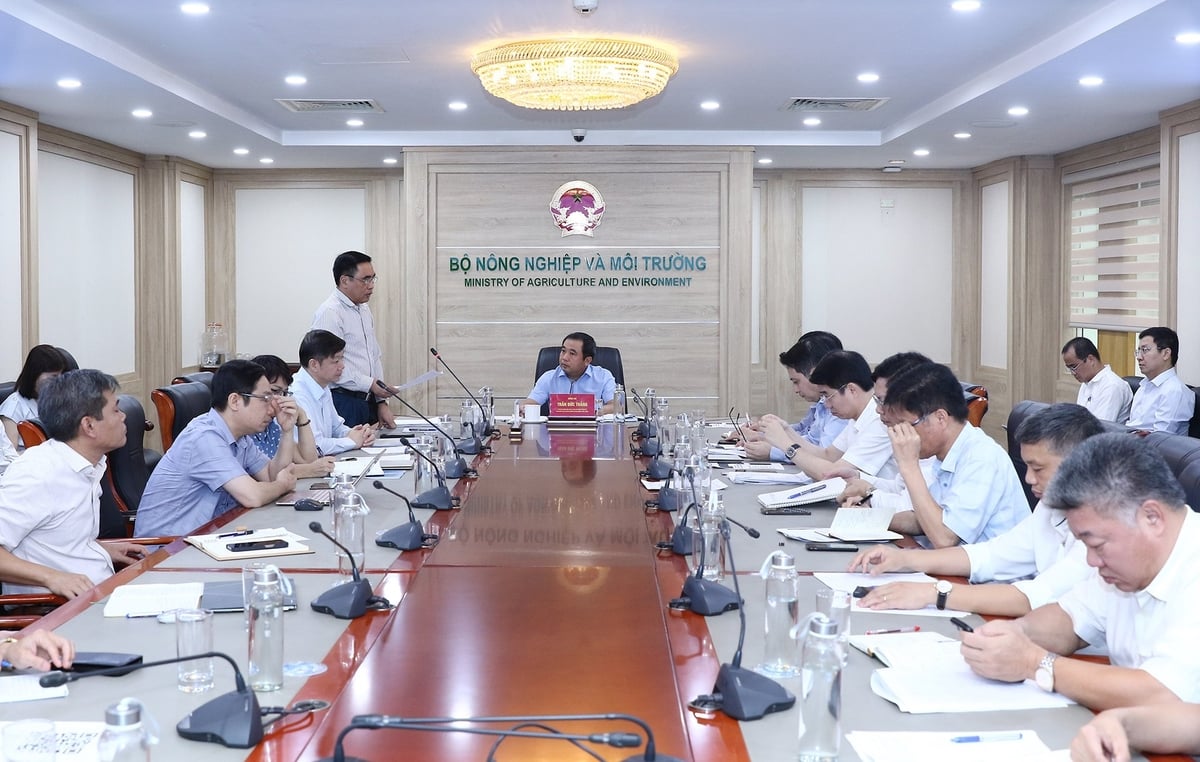October 26, 2025 | 03:51 GMT +7
October 26, 2025 | 03:51 GMT +7
Hotline: 0913.378.918
October 26, 2025 | 03:51 GMT +7
Hotline: 0913.378.918
The sector is facing strong demands for reform in management, protection, and development. Forests and biodiversity are not only an ecological shield but also the livelihood of millions of people.
On the morning of August 21, at a meeting chaired by Acting Minister of Agriculture and Environment Tran Duc Thang with the Ministry’s specialized agencies in these two fields, discussions centred on reviewing legislation, streamlining research organizations, and improving mechanisms and policies to ensure adequate resources for forest protection.

Acting Minister Tran Duc Thang chairs a meeting with specialized agencies in forestry and biodiversity, focusing on completing management strategies, human resource policies, and sustainable development to protect forests for future generations. Photo: Khuong Trung.
The Department of Nature Conservation and Biodiversity proposed that the Minister and Deputy Ministers continue to provide close guidance, establish inter-sectoral coordination mechanisms, and review and revise the Law on Biodiversity and related regulations to align with international commitments. It also recommended retaining the National Biodiversity Conservation Plan, consolidating personnel, and strengthening resources for implementation.
The Forestry and Forest Protection Department suggested reviewing the financial autonomy of management boards to match their functions, while ensuring budget allocations for routine operations and projects. It also requested authorization to prepare and implement forestry, biodiversity conservation, and rural development projects funded by both domestic and international sources.
Another issue of concern was merging and revising legal regulations, particularly for the system of research institutes, to avoid overlaps and improve resource efficiency. For staff working at national parks, who are directly involved in conservation, delegates proposed special policies to attract and retain talent.
According to statistics, Vietnam’s forest area currently covers about 14.8 million hectares, of which 14.5 million hectares are managed by local authorities, forestry enterprises, and communities. Around 300,000 hectares are under direct central management, underscoring the decisive role of local authorities in forest protection.

Deputy Minister Nguyen Quoc Tri speaking at the meeting. Photo: Khuong Trung.
Deputy Minister Nguyen Quoc Tri noted the shortcomings of multiple overlapping programs from agriculture and poverty reduction to target programs for ethnic minorities, simultaneously carrying out forest protection. He emphasized that the Forestry Department should concentrate on core tasks such as forest protection, supporting localities, wildfire prevention, and state management, while leveraging the role of timber and forest product associations. Regarding research, he stressed that conservation should focus on native species, while production should rely on high-quality varieties. He also highlighted the need to build a Vietnamese timber brand in traditional and potential international markets to prevent counterfeiting, and proposed establishing a modern nationwide forest fire prevention and control command center.
At the meeting, Acting Minister Tran Duc Thang stressed the importance of maintaining actual forest area, not “virtual statistics”. Biodiversity work, he said, must be more proactive, with tighter coordination among units. He affirmed that departments and agencies must boldly propose solutions rather than passively waiting for directives.
He also suggested mobilizing resources for forest protection through environmental lease mechanisms, which some localities have effectively applied to generate revenue and create jobs. In the long term, the sector must complete the Forestry Strategy to be submitted to the Prime Minister, tied to sustainable development goals, environmental protection, and livelihood security.

Acting Minister of Agriculture and Environment Tran Duc Thang delivers instructions at the meeting. Photo: Khuong Trung.
Through the meeting, four major directions were agreed upon: clearly defining forest status and area; developing a comprehensive strategy from 2026; improving management efficiency, human resource policies, and revenue sources from forests; and boosting research and training of high-quality personnel.
Acting Minister Tran Duc Thang stated that if implemented comprehensively, these directions will lay the foundation for sustainable forestry development, ensuring a balance of ecological, economic, and social benefits, while preserving forest resources for future generations.
Vietnam has a total forest area of about 14.8 million hectares, of which local authorities, forestry enterprises, and communities manage 14.5 million hectares, while around 300,000 hectares fall under direct central management. Forests are considered both an ecological shield and a livelihood source for millions of people.
In recent years, the forestry and biodiversity sectors have been under pressure to modernize management, align with international commitments, and ensure sustainable development. The government has introduced multiple programs, from biodiversity conservation and wildfire prevention to poverty reduction and ethnic minority support that overlap in forest protection.
Translated by Linh Linh

(VAN) Building on the commitment to advance the Strategic Partnership, the two countries’ agriculture will reach a consensus on a cooperation framework in November.

(VAN) Innovation, science, technology, and international cooperation are key factors in proactively preventing and managing integrated disaster risks.
/2025/10/24/2301-4-112019_374.jpg)
(VAN) Immediately after the joint statement issued by the two countries' leaders, the Ministers of Viet Nam and Bulgaria held a meeting to concretize cooperation in agriculture and fisheries and to promote trade and investment.

(VAN) Linking forest environmental service payments with coffee production is paving the way for a green and sustainable development path for the Central Highlands’ key agricultural sector.

(VAN) Agroecological models can be viewed as a form of ‘localized One Health,’ as they are rooted in the culture, environment, and practices of local communities.

(VAN) Acting Minister of Agriculture and Environment Tran Duc Thang and Finland’s Minister of Agriculture and Forestry Sari Essayah agreed to broaden bilateral cooperation in agriculture, forestry, and environmental protection.

(VAN) U.N. Secretary-General Antonio Guterres urged countries on Wednesday to implement disaster warning systems to protect people against extreme weather, saying no country was safe from the effects of global warming.